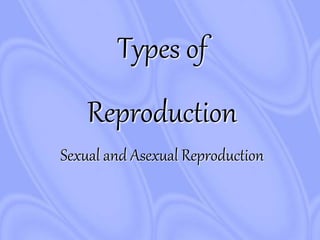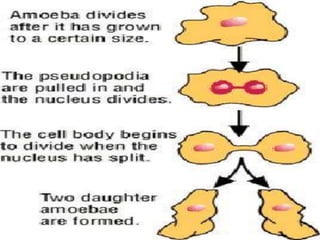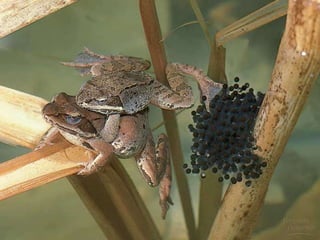Reproduction
- 1. REPRODUCTION
- 2. Reproduction • Reproduction (or procreation or breeding) is the biological process by which new individual organisms – "offspring" – are produced from their "parents". • Reproduction is a fundamental feature of all known life; each individual organism exists as the result of reproduction
- 3. Types of Reproduction Sexual and Asexual Reproduction
- 4. Asexual Reproduction: • Organisms that reproduce asexually cannot develop much variety, because they are “copying” the original organism exactly. • requires only 1 parent and the offspring are an exact copy of the parent---a clone
- 5. Methods of asexual reproduction: Binary fission Budding Fragmentation
- 6. BINARY FISSION Single-celled organisms (Amoeba, paramecium, euglena) which use asexual reproduction can do so simply by dividing into two equal halves. .
- 8. Budding- an offspring grows out of the body of the parent.
- 10. BUDDING In yeasts the cell does not divide equally in two halves; instead, there is a large mother cell and a smaller daughter cell.
- 11. Yeast - budding
- 12. FRAGMENTATION In this form, the body of the parent breaks into distinct pieces, each of which can produce an offspring.
- 13. Pieces of coral broken off in storms can grow into new colonies. A new starfish can grow from one detached arm.
- 14. SEXUAL REPRODUCTION • Requiring 2 parents –male and female (egg & sperm) • The egg and sperm join (zygote) to form an entirely new organism • Offspring are different from the parent organism
- 15. Methods of sexual reproduction: Pollination External Fertilization Internal Fertilization
- 16. Pollen is produced in the male organs of the flowers - anthers. Pollination occurs when pollen is transferred from the anthers to the female organs by wind or by animals. If the female stigma is receptive to a pollen grain, the pollen produces a pollen tube, which grows through the female tissue to the egg, where fertilization takes place by the sperm nucleus. Sexual Reproduction in Flowering Plants
- 18. External Fertilization • External fertilization usually requires a medium such as water, which the sperms can use to swim towards the egg cell. External fertilization usually occur in fish and amphibians. • The females lay the eggs in the water and the male squirts the sperm in the same area.
- 20. INTERNAL FERTILIZATION •Fertilization occurs within the female. •Internal fertilization occurs in mammals, insects, birds, reptiles.





















